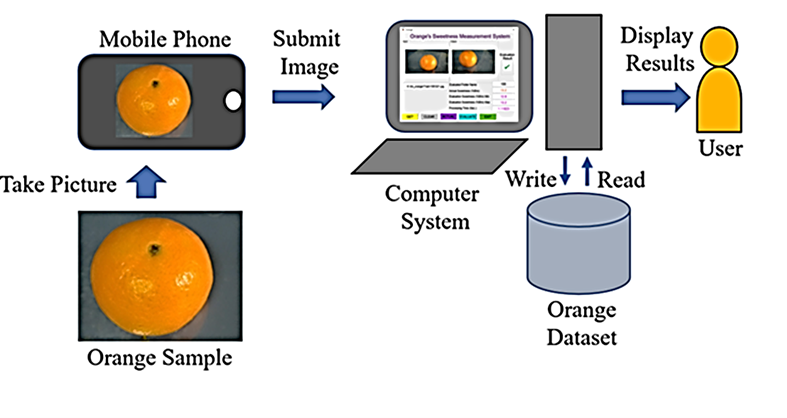
Chomtip Pornpanomchai
Faculty of Information and Communication Technology, Mahidol University 999 Phuttamonthon 4 Road, Salaya, Nakhon Pathom 73170, Thailand
DOI: https://doi.org/10.14456/apst.2025.68
Keywords: Brix convolutional neural network image processing orange ResNet50 sweetness measurement
Abstract
This research aims to develop a computer system that can evaluate an orange’s sweetness from a single image. The system is called orange sweetness measurement system (OSMS). The system was used on 120 orange images taken from 20 video clips, each lasting 60 s. The system extracted 400 video frames as images from each video clip. It used 200 images to train the system and the remainder to validate it. The system employed ResNet50 to train, validate, and recognize orange images. It had eight procedures, 1) collecting oranges, 2) making orange video clips, 3) squeezing orange juice, 4) measuring orange sweetness with a refractometer, 5) training the dataset, 6) imaging to evaluate orange sweetness, 7) recognize an orange image, and 8) display recognition results and sweetness values. The precision rate of the system is 99.35%, with an average access time of 1.5248 s/image. Based on the experimental results, orange sweetness can be measured using only a single image.
How to Cite
Pornpanomchai, C. (2025). Image-based orange (Citrus Reticulata and Citrus Reticulata Blanco) sweetness measurement by ResNet50. Asia-Pacific Journal of Science and Technology, 30(05), APST–30. https://doi.org/10.14456/apst.2025.68
References
Ghazali H, Rosman R, Sharif Z. Soluble solid content determination of limau madu using microwave sensing technique at 2.0-2.6 GHz. IOP Conf Ser Mater Sci Eng. 2018; 341: 012006.
Sammarraie MAJ, Gierz L, Przybył K, Koszela K, Szychta M, Brzykcy J, Baranowska. Predicting fruit’s sweetness using artificial intelligence – Case study: orange. Appl Sci. 2022; 12:1-13.
Giavoni M, Villanueva-Suárez MJ, RD Peña-Armada, Alejandra AGA, Mateos-Aparicio I. Pasteurization modifies the sensorial attributes and nutritional profile of orange pulp by-product. Foods. 2022; 11: 1-11.
Simons T, McNeil C, Pham VD, Wang S, Wang Y, et al. Chemical and sensory analysis of commercial Navel oranges in California. Sci Food. 2019; 3(22): 1-11.
Puig AB, Melon MC, Ortola MD, Cortes IL. Proposal of a New Orange selection process using sensory panels and AHP. Int J Environ Res Public Health. 2021; 18(7):1-17.
Adelkhani A, Beheshti B, Minaei S, Javadikia P, Varnamkhasti MG. Taste characterization of orange using image processing combined with ANFIS. Measurement. 2013; 46:3573-3580.
Obenland D, Collin S, Mackey B, Sievert J, Fjeld K, Arpaia ML. Determinants of acceptability of flavor during the maturation of navel oranges. Postharvest Biol Technol. 2009; 52:156-163.
Rosman R, Dimon MN, Yeow YK. Correlation between reflection coefficient, dielectric properties and Brix level of Malaysian oranges at microwave frequencies. Indonesian J Elec Eng & Comp Sci. 2018; 10: 853-858.
Giavoni M, Villanueva-Suárez MJ, Peña-Armada RD, Garcia-Alonso AA IM. Aparicio. Pasteurization modifies the sensorial attributes and nutritional profile of orange pulp by-products. Foods. 2022; 11: 1-11.
Ghazali H, Rosman R, Sharif Z. Measurement of brix level of Malaysian local oranges at resonance frequency. J Fundam Appl Sci. 2017; 9(4s): 629 -38.
Aini N, Dwiyanti H, Setyawati R, Handayani I, Septiana AT, Sustriawan B, et al. Siam orange (Citrus nobilis L.) nectar characteristics with variations in stabilizer and sucrose level. Food Res. 2022; 6 (3): 315–323.
Shyam NJ, Pranita J, Narsaiah K, Mansha G, Rishi B, Ashish KS. Non-destructive prediction of sweetness of intact mango using near infrared. Sci Hortic. 2012; 138: 171-175.
Rosman R, Dimon MN, Yeow YK. CST simulation on monopole sensor for determination of Malaysian local orange sweetness quality non-destructively. IOP Conf. Ser. Mater Sci Eng. 2014; 1301: 011002.
Singh H, Sridhar A, Saini SS. Ultra-low-cost self-referencing multispectral detector for non-destructive measurement of fruit quality. Food Anal Methods. 2020; 13: 1879–1893.
Ngowsuwan K, Thanapatay D, Kasemsumran S. Performance improvement of temperature compensation in near infrared analysis of orange sweetness by applying direct standardization. J Near Infrared Spectrosc. 2018; 26(6): 369-378.
Zeb A, Qureshi WS, Ghafoor A, Malik A, Imran M, Mirza A, et a. Towards sweetness classification of orange cultivars using shortwave NIR spectroscopy. Sci Rep. 2023; 13: 1-12.
Ncama K, Opara UI, Tesfay SZ, Fawole OA, Magwaza LS. Application of Vis/NIR spectroscopy for predicting sweetness and flavour parameters of valencia orange (Citrus sinensis) and Star Ruby grapefruit (Citrus x paradisi Macfad). J Food Eng. 2017; 193: 86-94.
Calvo C, Salvador A, Susana MF. Influence of colour intensity on the perception of colour and sweetness in various fruit-flavoured yoghurts. Eur Food Res Technol. 2001; 213: 99–103.
Fiona R, Thomas S, Maria IJ, Hannah B. Identification of ripe and unripe citrus fruits using artificial neural network. J Phys Conf Ser. 2019; 1362, 1-8.
Salaiwarakul A, Mungklachaiya S. A simple deep learning model for classifying oranges in embedded manufacturing settings. SSRN. 2023;4: 1-21.
Wang H, Wu C, Hirafuji M. Visible light image-based method for sugar content classification of citrus. PLoS ONE. 2016; 11(1): 1-16.
Erdem D, Beke A, Kumbasar T. A deep learning-based pipeline for teaching control theory: transforming feedback control systems on whiteboard into MATLAB. IEEE Access. 2022; 8: 84631-84641.
Sangsongfa A, Amdee N, Meesad F. Prediction of pineapple sweetness from images using convolutional neural network. EAI Endorsed Transactions. CASA. 2022; 7(21): 1-7.
Pornpanomchai C, Vajarobola A, Leadkeattiwong K, Limpitigranon P. Banana (Musa Acuminata Triploid AAA, Cavendish) sweetness measurement by digital image processing technique. Int J Des Anal Tools Integr Circuits Syst. 2018; 7(1): 34-37.

Published:
License
This work is licensed under a Creative Commons Attribution-NonCommercial-NoDerivatives 4.0 International License.
